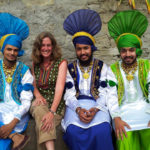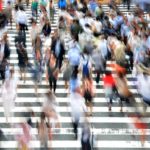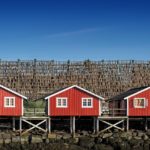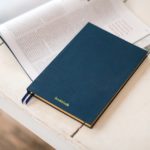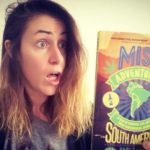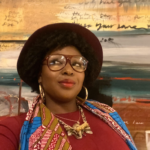Drawing Maps in Haiti: In Conversation with Allison Coffelt

When I first traveled to Haiti in January 2010, I didn’t know what I didn’t know. I didn’t know much about the culture, people, or lifestyle except for the widespread poverty associated with the country. I’d decided to travel there on a whim, because I could and because it seemed like it would help (help who? being a question I would chew over afterwards).
I didn’t know that exactly a week after returning home, a magnitude 7.0 earthquake would tear through the nation, devastating its infrastructure and people. I certainly didn’t know that eight years later, the president of the United States would be referring to it as a “shithole country”.
Not Haiti. Not the nation whose strong communities were apparent in every dance and every song, whose generosity was like the sea – warm, inviting, and enveloping. I didn’t know that in all the years since visiting, I would still be wondering about my place in it all. Or, as Allison Coffelt so masterfully puts, “I am still unpacking Haiti. I probably always will be.”
In her debut book Maps are Lines We Draw: A Road Trip through Haiti, Coffelt combines research, memoir, and travel tales to create a unique non-fiction book that explores the various narratives prevailing in Haiti. In her lyrical style, she weaves together the performance of subjects such as language, health, history, water and aid to the layout of the country – all while sharing insights from her own adventure, constantly curious as to how she fits into the puzzle.
Coffelt has written a beautifully cognizant piece of work that addresses privilege, global empathy, and the palpable gray area of the savior-victim rhetoric.
Readers witness not only the heart of Haiti, but also the soul of the author in a moving account they won’t be able to shake.
In addition to providing the history most readers don’t have but need to know about Haiti, she offers an in-depth look at herself. Her words are private thoughts made public – pure and emotional and vulnerable. Readers witness not only the heart of Haiti, but also the soul of the author in a moving account they won’t be able to shake.
“We don’t always get to choose our here. But sometimes we can design its breadth: how far its boundaries reach across, over, and around our globes. We can decide what or whom this here includes.”
Reading Maps are Lines We Draw transported me back to my own experiences in Haiti. What role had I played while there? What roles do I play in my here? Coffelt eloquently voiced an inner monologue I was desperately familiar with, and produced a book anyone who is interested in, travelling to, or a previous visitor of Haiti should read.
Inspired by Tracy Kidder’s Mountains Beyond Mountains, Coffelt transformed her decade of interest into a memorable, informative trip and passionate book that everyone can learn from, whether it is about the rebellious rise of Haiti as a nation, the global impact of the fashion and textile industry, how to begin again after terrifying natural disasters, or simply our choices as travelers.
I was pleased to get the time to speak to Allison Coffelt about her inspiring book.
Drawing Maps in Haiti: In Conversation with Allison Coffelt
Did you travel to Haiti knowing you wanted to write about it?
I travelled to Haiti in the summer of 2013 and I knew I was interested in writing something. I had brought along a voice recorder, notebooks, and my computer to log interviews and store photos, but part of me knew I’d be writing in a more substantial way.
For context, I had just left my job and was about to start grad school, so I had the time to focus on writing. I knew I had a longstanding interest in Haiti, and could see myself taking my casual research and ramping it up, but I didn’t admit to myself that I was writing a book. It seemed outlandish! Even to declare it internally felt too big.
It’s like I had to trick myself into writing a book. Oh, I’m taking a bunch of notes and recording interviews. Oh, I’m just recording things for the donor newsletter.
Speaking of research, what did you need to do to write this book?
I had been reading extensively before I left for Haiti, it was probably 5 or 6 years of reading. This included global health books that weren’t necessarily about Haiti specifically but about aid; history books such as about the textile industry. I had also studied International Relations and English in college, so there was a lot of intersection between that work and my own interests.
When I started graduate school in 2013, I was able to use the university setting for more in-depth research. There were just so many people and tools I had access to, like old travel guides for example. But it was probably five or maybe even more years of active progress until February 2017 when the book was accepted for publication.
Your book has such a unique approach in its layout. How did you pick the structure you used?
I really worked on the different layers. The book is like a subsection of nonfiction writing that isn’t exactly memoir, personal essay, or research. Structure was the hardest part for me to write. I started with a long first manuscript for 2-3 years, because it was hard to figure out what exactly it was, and figuring out where my voice fit in in this narrative around Haiti and nonfiction.
I really focused on how much of my own narrative needed to be in this piece of work in comparison to other elements. And I swiveled quite a lot with having too much of other people’s voices! It felt like putting together a puzzle with a blindfold on, in the dark, with my hands tied behind my back. I really wasn’t sure of what all pieces were, how they worked together, or how they spoke to each other.
Eventually it took more intuition than anything else. A structure began to emerge and I needed bravery to move forward with it, with this broken, interrupted lyric structure that I was concerned was too much in vogue. I tried several things, but eventually followed my hunch on this self-interrupted style that physically and spatially represented my doubts without constantly speaking them. But I had to think about all of the pieces to be able to weave them together.
Your book explores the idea of here/there, us/them, and our need as travelers to separate and join them together.
Where and how do we draw our lines? Not only as travelers, but in our daily life: when I am available to connect versus needing to put up a wall? How do we connect to people travelling through life? If you picture visually walking around with a circle around you, how far does your circle extend?
What is the significance of our choices to extend or not extend our circle? I think considering this, especially as Americans, is an opportunity for us to see lives, moments, and countries not only as distinct, but to connect them with the history of other nations.
We walk around with all of this forgotten history that we can’t evolve past.
Junot Diaz talks about an amnesia we walk around with, an amnesia that comes with being American. We walk around with all of this forgotten history that we can’t evolve past. Discussing the idea of here/there is a request for us to recognize the connections between us and things we assume are not connected.
Take the extra steps, be curious: it’s an opportunity to learn about connections we otherwise don’t see.
You write, “I’m not so sure knowing this trap gets me out of it. I’m not so sure I’m different” in regards to the danger of the mission trip narrative and how we present not only ourselves and our stories when traveling, but also others and their stories. What lesson are you trying to convey?
The question to articulate is “how do you fit in both the larger or smaller scale?” The idea of “oh they need help” often influences people to get involved and help, which is wonderful. But anytime we are experiencing a sense of contribution, it is good to reflect and apply a level of critical thinking to the aid we provide and our own feelings of being bolstered by it.
Often, when we cross bigger borders, we don’t always bring same level of critical thinking. It can be easy to slip into existing narratives, whether it is one of the white savior or of helplessness. It may be difficult to ask the questions of “where do I fit in?” but they are questions worth asking, especially in a country like Haiti, where your place in the community may be harder to know due to unknown history.
What is the one thing people should know about the role of the US in Haiti?
Oh wow, there’s a lot! We have Chicago because of a Haitian immigrant. The US occupied Haiti in early 1990s. So much of what we consume, like coffee and sugar, came from Haiti for a significant amount of time.
In one chapter, you write about water, but in many ways it is about more than water. It is about the widespread ramifications of disease and the faults of even the largest aid organizations. What was it like writing this chapter?
With news of the cholera outbreak in Haiti, I had an “oh my god” reaction. I largely relied on The Big Truck That Went By: How the World Came to Save Haiti and Left a Disaster, which is the story that broke the news on where cholera was originating from. Previously I had been following the news closely and even remember doing fundraisers for both the earthquake and the cholera outbreak. But reading the book brought the story together in a condensed, very powerful way.
It connected all these important dots. I knew I wanted to address the issue in the book, in part because of a fascination about water. There’s nothing like it. It moves so fluidly. It connects everything. A lot really resonates with underlying threads of the book. How does water move in the body, the body move in community, water move in community?
Let’s talk about the dependence, or rather the symbiosis as you call it, of aid organizations who help just enough to make a difference and also keep themselves in work. How can people support sustainable organizations that actually help to terminate real issues in Haiti and around the world?
The best work that I have seen in global health and poor developing countries are the ones that do two things. One, they redistribute resources to the people who live and work in the country, including having them in a deciding role. You need to consider how much opportunity is being offered to involve the people from where you are serving. Are there steps for inclusion in the decision making process?
Yes it’s messy and hard, but it’s their country and space, and you should not try to take their authority. Two, they focus on employment and training. How many natives are being employed versus people being flown in? How many people are you training so the work can continue?
Aid goes beyond money; it is about knowledge and training. Public institutions may not be perfect, but they exist and are where permanent institutionalized change will start. There’s not a perfect organization doing everything right. Mistakes are going to be made. Resilience is a sign of true partnership that centers feedback and needs, trusting each other to know what’s best.
Maps are Lines We Draw will be published on March 20th 2018, from Lanternfish Press.
Drawing Maps in Haiti: In Conversation with Allison Coffelt
Related Reading
Music and Medical Missions Trip to Haiti: A Conversation With Aliz Koletas
Haiti Travel: Heart Breaking Living Conditions
Travel Haiti: A Coversation with Melissa Adler
Have you traveled to Haiti? What where your impressions? Email us at editor@pinkpangea.com for information about sharing your experience and advice with the Pink Pangea community. We can’t wait to hear from you.
Drawing Maps in Haiti: In Conversation with Allison Coffelt photo credit: Pixabay

